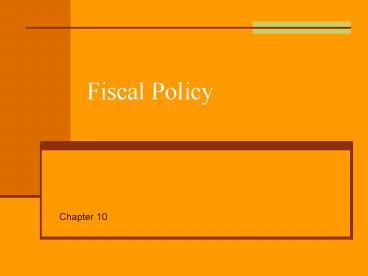Fiscal Policy - PowerPoint PPT Presentation
1 / 26
Title: Fiscal Policy
1
Fiscal Policy
- Chapter 10
2
Drop models assumption of no government
- Roles for government
- Education
- Defense
- Administration of justice
- Provide infrastructure (roads, bridges, etc)
- Regulation
- Maintain full employment (since 1948)
- Fiscal policy govt spending tax policy
intended to stabilize the macroeconomy
3
Adding Government to AD
- AD C II G
- G f(?)
- What explains government spending behavior?
- Like investment, its too complicated, so all G
is autonomous
4
Table 10.1 An Increase in Government Spending
5
Interium summary
- AD C II G
- C f(Y)
- II G are both autonomous C too
- AD AEXP mpc(Y)
- AD (C II G) mpc(Y)
- AD (20 60 80) 0.8(Y)
- AD 160 0.8Y
6
Figure 10.1 Increased Government Spending
7
Taxes and Transfer Payments
- Yd Y T TR
- C f(Yd)
- If taxes? ? Yd?, hence consumption function
shifts up - If TR ? ? Yd?
- Both have similar effect as G?
8
Multipliers
- Spending multiplier
- ?Y (1/(1 mpc) ?G
- By increasing G 80B, equilibrium income rose
from 400 to 800 Table 10.1 - ?Y (1/(1 0.8)80 580 400
- Tax multiplier
- More indirect, because it changes Yd, which then
affects C and AD - Formula pg. 10-7 but dont worry about it
- Also, dont worry about balanced budget
multiplier
9
No Fault
10
Fiscal Policy What is it?
- The adjustment of tax rates and/or federal
government spending in order to stabilize the
economy - To eliminate recessions (unemployment)
- To eliminate inflation
- Conducted by the President and Congress
11
Fiscal policy a counterweight to trouble
- When a recession is threatened .
- Use expansionary fiscal policy
- Want to shift AD up
- G?, TR?, T?
- When inflation is threatened
- Use contractionary policy
- Want to shift AD down
- G ?, TR?, T?
12
Fiscal policy limitations
- Forecasting lag
- Data
- Recognition
- Action lag
- Legislation
- Transmission
- Impact lag
- Multiplier impact (outside)
FAIL
13
Back to Laissez Faire?
- Automatic stabilizers p.10-16
- Govt spending programs already in place that
respond as a counterweight without further
legislation or other discretionary steps. - Examples
- Unemployment insurance
- Welfare payments
- Income tax receipts
- Not exactly laissez faire, since these are
government safety net programs
14
Which of the following are examples of automatic
stabilizers, and which are examples of
discretionary policy? Could some be both? (1)
Tax revenues rise during an economic
expansion (2) Personal tax rates are reduced (3)
Government spending on highways is increased (4)
Farm support payments increase (5) Unemployment
payments rise during a recession
A Automatic stabilizer B Both D
Discretionary
15
Congressman Paul reading threats to national
security?
- What are the Congressmans main conclusions?
- How does he support them with evidence and
arguments? - Should we be worried? What points does your
textbook raise that support or question his
conclusions? - http//www.whitehouse.gov/omb/budget/fy2008/pdf/ap
ers/borrowing.pdf - Table 16.1, page 3 Table 16.6, page 15 of pdf
file.
16
Finishing the model adding the international
sector
- AD C II G NX
- NX eXports IMports
- Most recent data
- NX (X IM) 1600B - 2300B -700B
- 2007 Q2, in current dollars
- To keep the model simple
- X and M are assumed autonomous
17
Figure 10.6 Leakages and Injections in a
Complete Macroeconomic Model
18
Revenues expenditures
19
Figure 10.2 U.S. Federal Government Source of
Funds and Outlays, 2005 (to be continued)
20
(continued) Figure 10.2 U.S. Federal
Government Source of Funds and Outlays, 2005
21
Deficit Debt
- Deficit/surplus annual
- Budget surplus () or Deficit (-)
- T (G TR)
- Figure 10.3
- Debt accumulated past deficits (going back to
the Revolutionary War) - Figure 10.4
22
Figure 10.3 The Government Deficit as a
Percentage of GDP
23
Figure 10.4 Government Debt Held by the Public
as a Percentage of GDP
24
Figure 10.5 Government outlays, taxes and
surplus/deficit as GDP
25
Figure 10.6 Leakages and Injections in a
Complete Macroeconomic Model
26
Figure 10.7 A Cut in the Proportional Tax Rate































